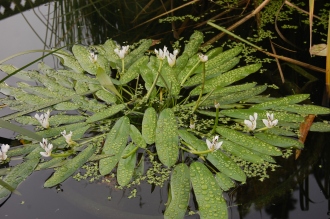Position: Full sun to partial shade
Flowering period: Spring and Autumn to early winter
Soil: Wet (planting depth 30cm – 90cm)
Eventual Height: 10cm (above water level)
Eventual Spread: 90cm
Hardiness: 9a, 9b, 10a, 10b
Family: Aponogetonaceae
Aponogeton distachyos is a deciduous, aquatic plant. Its mid green leaves are narrow oval with entire margins, up to 25cm long, 7cm broad, these float on the water surface. Its fragrant white flowers are produced on an erect spike and are held above the water surface. Its fruit. Its roots are tuberous rhizomes.
Aponogeton distachyos, commonly known as Waterblommetjie, Cape Pondweed, Water Hawthorn, Vleikos, or Cape Asparagus, is native to South Africa. In its native habitat it grows in ponds which dry up in summer, becoming dormant during the summer months. In its native South Africa its buds and flowers are eaten. It was introduced into Europe in the 1600’s. It has become naturalised in Australia, and parts of Europe and USA.
The etymological root of the binomial name Aponogeton is derived from the Greek aponos meaning ‘without’ and geitwn meaning ‘neighbour’. Distachyos is derived from the Latin meaning ‘two spiked’, in reference to the flower spikes.
The landscape architect may find Aponogeton distachyos useful as part of a pond planting scheme. It may also be used as part of a SUDS scheme, where conditions are suitable.
Ecologically, Aponogeton distachyos flowers are attractive to pollinating insects, particularly bees.
Aponogeton distachyos prefers wet, fertile, soils. It tolerates most pH of soil. It should be planted at a water depth of 30cm to 90cm.
Aponogeton distachyos requires little maintenance. Large clumps may be divided in winter to early spring.





